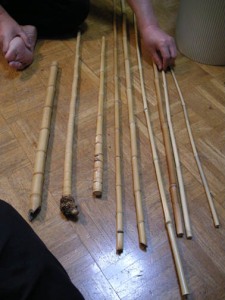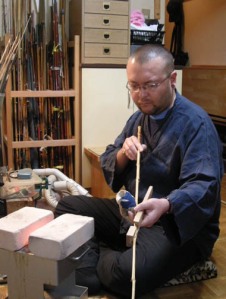All the bad weather we have been having this month – I haven’t been out to sea once in March – has allowed me to concentrate on my rod making, which is difficult but rewarding. I am lucky I have a good sensei, who is patient, if stern, and a good teacher. The shirogisu (whiting) rod I started last year should be ready in a month or so, just in time for the Tokyo Bay whiting season. At the moment the rod is in the lacquering stage, using traditional Japanese urushi (wood lacquer).


Left: my teacher displaying some of the different types of Japanese bamboo, and explaining their various uses. Fibreglass or baleen is also sometimes used for the rod tip. Right: straightening the bamboo, by heating it over a fire and bending it into place.

Hi Adam,
You look like a “Shokunin” for fishing rod. What kind of Japanese rod can be made of Japanese bamboo? I used to have a Japanese bamboo rod for Herabuna but I have never used any Japanese rod for sea fishing.
I hope you will be ready for shirogisu season.
Hi Shin,
Normally if I wear “samue” people say I look like a monk, so I am glad you say that.
For saltwater fishing the main rods are haze, kisu and kawahagi. Also to a lesser extent, tai and aoriika (both for shakuri-style fishing), fugu, karei and for shore fishing, ishidai.
The 42cm karei I caught last month was with a bamboo rod with baleen tip; it was much more exciting using a bamboo rod instead of graphite.
The next rod I am planning to make is for herabuna.
Cheers,
Adam
hi adam, I have been following your website here for a while and love your cooking and postings. I have a question, is bamboo stronger than graphite or more flexible, what attributes cons and pro would you contribute to bamboo rods compared to normal rods.
also I would like to buy japanese fishing rods for my collection (i live in florida) and wandered if you know of any websites that sell and will ship them here to the states from japan.
thanks
shar
Hi Shar,
Thank you for visiting and for posting.
In short, bamboo is definitely not as strong as graphite when made into a fishing rod, but is much lighter and more flexible. Also, the ‘recoil’ of a bamboo rod is gentler and closer to that of a fibreglass rod, but without the weight. Bamboo ‘cane’ fly fishing rods are a good example of this.
I’m afraid I don’t know a rodmaker that will ship to the US. The rods are pretty expensive (e.g., the starting price for a whiting rod made by a pro would be 50-60,000 yen; the better class of whiting rod three times that) and I think most makers would be leery of mailing the rods over long distance, as they are susceptible to changes in humidity and temperature. Japanese bamboo rods need a lot more care and attention than graphite; at the least, a trip back to its maker at least once a year to be waxed and re-straightened.
are bambooo rods not as strong as graphite ones? do you have to use a higher weight of rod made of bamboo than a graphite one? am going to but one to fish once a year or so on a river but mainly a small stillwater which is stocked with trout weighing 3 pound or so some more. what would you suggest?
Hi Simon,
You can buy short bamboo rods specifically made for trout fishing; most can deal with the size of fish in stocked ponds here. Generally bamboo rods are fine so long as you use them for the fishing they were intended for (e.g., don’t cast for seabass or koi with a trout rod), but they can’t take as much abuse as graphite. This is especially true when you snag the bottom or debris. Having said that, in my experience I’ve never seen a bamboo rod snapped by a fish, only by bad handling or storage. 9/10 times this is an over-excited angler who puts too much effort into setting the hook and this is the most common cause of bamboo breakage.
Cheers,
Adam
thanks for the quick response. so 5 or 6 weight of a bamboo rod would be able to handle the fish just as well as my 5/6 weight graphite? but its just the care and maintenance that should be noted?
thanks
simon
Simon,
You should be fine if you have a little fishing experience and don’t yank the rod all over the place.
Yes, the main difference is the maintenance; you need to clean and dry the rod each time after use, but you can’t just run them under a tap or shower or scrub them with a coarse brush like you can with synthetic materials. Also you must never leave your rods stored in the car or in the sun as they will warp out of shape. But the fishing itself is amazing, when you have a fish on on a bamboo rod it’s completely different!
Cheers,
Adam
thanks
cleared up alot of issues,
was worried if it could withstand the fish and if i had to get a heavier weight rod. wish you the best of luck in your projects
simon
Simon, if you need any info on how to look after your bamboo rod after you have bought it, please get in touch again.
Cheers & good luck fishing with your new rod!
Adam
hi again
do you think that a 7’6” #5 would be alright for trout on a small stillwater or the occasional river? or would you think a 8’O” #6 more suitable?
simon
Simon, I would go for the lighter rod, but that is my personal preference. I think using the appropriate sized leader/tippet, that will break off long before the rod snaps, is the best way to protect your rod, rather than going for a heavier rod.
Good luck fishing!
Cheers,
Adam
Dear Sirs,
I have a question for you.
I’m trying a fishing rod in bamboo, made in Japan, not a fly rod, but a rod that I can use at lake.
Can you help me?
Best regards,
Emanuele
Hi i from singapore, my wife is from osaka, i’m keen angler on all type of fishing trolling, jigging,surf casting, casting, prawning , one day i woke up i told myslelf that i want to make a bamboo rod, after research i try to make a split bamboo rod but it broke as the glue is not perfect, then i discovered japanese rod making , the problem i have is that it always broke at the joint section ( 1 kg snapper ) , as it a trial an error for me would u give me some tips, most youtube did not show the whole process, i use whatever material is available here in singapore, normal wood lacquer, bamboo from flower shop, question do i hollow the inner part of the bamboo or leave it as it is, if hollow do i lacquer the inner part also.
Please read this article I wrote for Fishing Fury in 2009 which describes making my first bamboo fishing rod:
http://www.fishingfury.com/making-a-traditional-japanese-bamboo-fishing-rod/